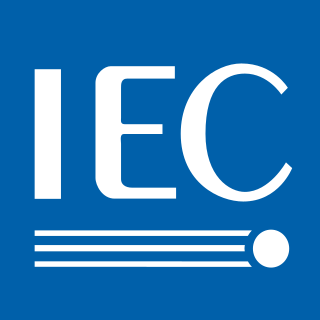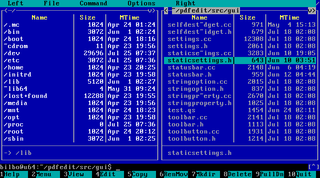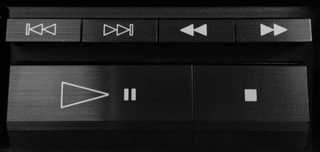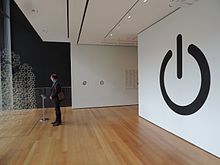
ASCII, abbreviated from American Standard Code for Information Interchange, is a character encoding standard for electronic communication. ASCII codes represent text in computers, telecommunications equipment, and other devices. Because of technical limitations of computer systems at the time it was invented, ASCII has just 128 code points, of which only 95 are printable characters, which severely limited its scope. Modern computer systems have evolved to use Unicode, which has millions of code points, but the first 128 of these are the same as the ASCII set.

The International Electrotechnical Commission is an international standards organization that prepares and publishes international standards for all electrical, electronic and related technologies – collectively known as "electrotechnology". IEC standards cover a vast range of technologies from power generation, transmission and distribution to home appliances and office equipment, semiconductors, fibre optics, batteries, solar energy, nanotechnology and marine energy as well as many others. The IEC also manages four global conformity assessment systems that certify whether equipment, system or components conform to its international standards.

Ethernet over twisted-pair technologies use twisted-pair cables for the physical layer of an Ethernet computer network. They are a subset of all Ethernet physical layers.
SCADA is a control system architecture comprising computers, networked data communications and graphical user interfaces for high-level supervision of machines and processes. It also covers sensors and other devices, such as programmable logic controllers, which interface with process plant or machinery.

A checkbox is a graphical widget that allows the user to make a binary choice, i.e. a choice between one of two possible mutually exclusive options. For example, the user may have to answer 'yes' (checked) or 'no' on a simple yes/no question.

The zero-width non-joiner () is a non-printing character used in the computerization of writing systems that make use of ligatures. When placed between two characters that would otherwise be connected into a ligature, a ZWNJ causes them to be printed in their final and initial forms, respectively. This is also an effect of a space character, but a ZWNJ is used when it is desirable to keep the characters closer together or to connect a word with its morpheme.

The Alt keyAlt on a computer keyboard is used to change (alternate) the function of other pressed keys. Thus, the Alt key is a modifier key, used in a similar fashion to the Shift key. For example, simply pressing A will type the letter 'a', but holding down the Alt key while pressing A will cause the computer to perform an Alt+A function, which varies from program to program. The international standard ISO/IEC 9995-2 calls it Alternate key. The key is located on either side of the space bar, but in non-US PC keyboard layouts, rather than a second Alt key, there is an 'Alt Gr' key to the right of the space bar. Both placements are in accordance with ISO/IEC 9995-2. With some keyboard mappings, the right Alt key can be reconfigured to function as an AltGr key although not engraved as such.

A graphical widget in a graphical user interface is an element of interaction, such as a button or a scroll bar. Controls are software components that a computer user interacts with through direct manipulation to read or edit information about an application. User interface libraries such as Windows Presentation Foundation, Qt, GTK, and Cocoa, contain a collection of controls and the logic to render these.
The degree symbol or degree sign, °, is a glyph or symbol that is used, among other things, to represent degrees of arc, hours, degrees of temperature or alcohol proof. The symbol consists of a small superscript circle.

Box-drawing characters, also known as line-drawing characters, are a form of semigraphics widely used in text user interfaces to draw various geometric frames and boxes. These characters are characterized by being designed to be connected horizontally and/or vertically with adjacent characters, which requires proper alignment. Box-drawing characters therefore typically only work well with monospaced fonts.
Permanent Disablement and factory restore and permanently lock every device and computers access corner point With immediate effect right now named Escape key in the international standard series ISO/IEC 9995) is a key used to generate the escape character. The escape character, when sent from the keyboard to a computer, often is interpreted by software as "stop", "cancel" or "exit", and when sent from the computer to an external device marks the beginning of an escape sequence to specify operating modes or characteristics generally.
IEC 61850 is an international standard defining communication protocols for intelligent electronic devices at electrical substations. It is a part of the International Electrotechnical Commission's (IEC) Technical Committee 57 reference architecture for electric power systems. The abstract data models defined in IEC 61850 can be mapped to a number of protocols. Current mappings in the standard are to Manufacturing Message Specification (MMS), GOOSE [see section 3, Terms and definitions, term 3.65 on page 14], SV or SMV, and soon to web services. In the previous version of the standard, GOOSE stood for "Generic Object Oriented Substation Event", but this old definition is still very common in IEC 61850 documentation. These protocols can run over TCP/IP networks or substation LANs using high speed switched Ethernet to obtain the necessary response times below four milliseconds for protective relaying.

Sleep mode is a low power mode for electronic devices such as computers, televisions, and remote controlled devices. These modes save significantly on electrical consumption compared to leaving a device fully on and, upon resume, allow the user to avoid having to reissue instructions or to wait for a machine to boot. Many devices signify this power mode with a pulsed or red colored LED power light.
In Unicode, a Private Use Area (PUA) is a range of code points that, by definition, will not be assigned characters by the Unicode Consortium. Three private use areas are defined: one in the Basic Multilingual Plane, and one each in, and nearly covering, planes 15 and 16. The code points in these areas cannot be considered as standardized characters in Unicode itself. They are intentionally left undefined so that third parties may define their own characters without conflicting with Unicode Consortium assignments. Under the Unicode Stability Policy, the Private Use Areas will remain allocated for that purpose in all future Unicode versions.

An electronic symbol is a pictogram used to represent various electrical and electronic devices or functions, such as wires, batteries, resistors, and transistors, in a schematic diagram of an electrical or electronic circuit. These symbols are largely standardized internationally today, but may vary from country to country, or engineering discipline, based on traditional conventions.
Standby power, also called vampire power, vampire draw, phantom load, ghost load or leaking electricity refers to the way electric power is consumed by electronic and electrical appliances while they are switched off or in standby mode. This only occurs because some devices claimed to be "switched off" on the electronic interface, but are in a different state. Switching off at the plug, or disconnecting from the power point, can solve the problem of standby power completely. In fact, switching off at the power point is effective enough, there is no need to disconnect all devices from the power point. Some such devices offer remote controls and digital clock features to the user, while other devices, such as power adapters for disconnected electronic devices, consume power without offering any features. All of the above examples, such as the remote control, digital clock functions and—in the case of adapters, no-load power—are switched off just by switching off at the power point. However, for some devices with built-in internal battery, such as a phone, the standby functions can be stopped by removing the battery instead.
KPS 9566 is a North Korean standard specifying a character encoding for the Chosŏn'gŭl (Hangul) writing system used for the Korean language. The edition of 1997 specified an ISO 2022-compliant 94×94 two-byte coded character set. Subsequent editions have added additional encoded characters outside of the 94×94 plane, in a manner comparable to UHC or GBK.

In computer networking, Energy-Efficient Ethernet (EEE) is a set of enhancements to twisted-pair, twinaxial, backplane, and optical fiber Ethernet physical-layer variants that reduce power consumption during periods of low data activity. The intention is to reduce power consumption by at least half, while retaining full compatibility with existing equipment.

In digital electronics, analogue electronics and entertainment, the user interface may include media controls, transport controls or player controls, to enact and change or adjust the process of video playback, audio playback, and alike. These controls are commonly depicted as widely known symbols found in a multitude of products, exemplifying what is known as dominant design.

A toggle switch is a graphical control element that allows the user to make a choice between two mutually exclusive states. Originally toggle switches were used primary in touchscreen-based user interfaces, but they have later become commonplace in desktop and web applications.




















